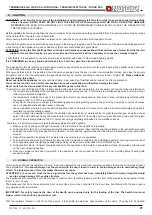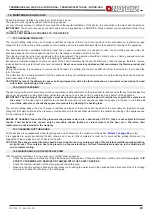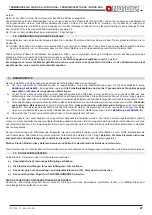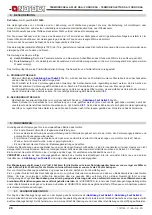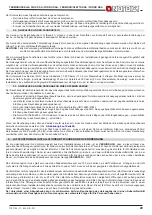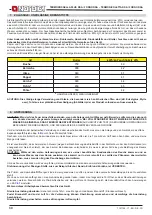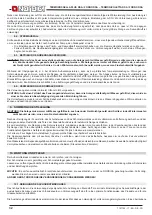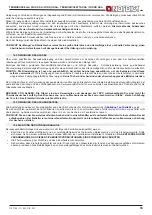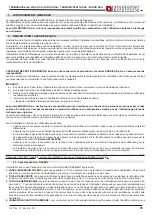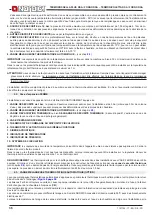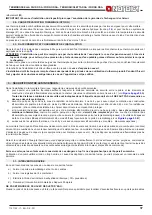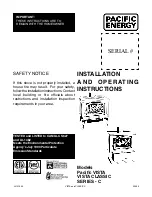
TERMOROSSELLA PLUS DSA / FORNO DSA – TERMONICOLETTA DSA / FORNO DSA
22
according to the calorific need. The best combustion (with minimum emissions) is reached when, by loading the wood, most part of the air
for combustion flows through the secondary air register.
Too much fuel and too much air for the combustion may cause overheating and then damage the stove, as a consequence some scratches
in the lower front part of the stove could happen.
The warranty does not cover the damages due to overheating of the equipment.
You should always use the appliance with the door closed in order to avoid damages due to overheating (forge effect).
The adjustment of the registers necessary to reach the rated calorific yield with a depression at the stack of 17-20 Pa (1,7-2 mm of column
of water) is the following one:
Fuel
PRIMARY air
SECONDARY air
Wood
CLOSED
OPEN
In the event that the water temperature exceeds the tripping temperature of the safety devices, immediately suspend the feeding
of wood, and make sure that the water temperature and the flame decrease, eliminating the causes of the overheating (if necessary
by closing the air register).
If the water system is connected in the thermo-product, the hot water tap can be opened to speed up the cooling of the appliance.
Besides the adjustment of the air for the combustion, the intensity of the combustion and consequently the thermal performance of the
device is influenced by the stack. A good draught of the stack requires a stricter adjustment of air for combustion, while a poor draught
requires a more precise adjustment of air for combustion.
To verify the good combustion, check whether the smoke coming out from the stack is transparent.
If it is white, it means that the device is not properly adjusted or the wood is too wet; if instead the smoke is gray or black, it signals that the
combustion is not complete (it is necessary a greater quantity of secondary air).
8.2. ELECTRICAL POWER SUPPLY FAILURE
In the event of an unexpected electrical power supply failure during normal system operation, it will be necessary to carry out these simple
manoeuvres to prevent the water in the boiler starting to boil as a consequence of the lack of pump operation.
a) Close completely the primary and secondary air registers in order to smother the flame as much as possible.
b) Close the smokes register, if existing, to limit further coming of combustive air through possible cracks.
8.3. OPERATION DURING TRANSITION PERIODS
ATTENTION
:
never light for any reason if the installation is not completely full of water in order to avoid a serious damage of the
whole structure
. The installation must always be full of water even when the thermo-product is not used. A possible no use during
winter season must be faced by adding antifreeze substances.
During transition periods when the external temperatures are higher, if there is a sudden increase of temperature it can happen that the
combustion gases inside the flue cannot be completely sucked up.
The exhaust gases do not come out completely (intense smell of gas). In this case, shake the grating more frequently and increase the air
for the combustion. Then, load a reduced quantity of fuel in order to permit a rapid burning (growing up of the flames) and the stabilization
of the draught.
Then, check that all openings for the cleaning and the connections to the stack are air-tight.
8.4. USE AS A NORMAL STOVE.
ATTENTION: For no reason must the fire be ignited before the system has been completely filled with water; doing this would
lead to serious damage of the entire structure
.
Use as a normal stove is NOT envisioned!
In order to prevent water boiling in the boiler, when the thermoheating stove is in function, the circulation pump must be in function in order
to dispose of the heat given to the boiler water on the radiators.
9. SUMMER TIME
ATTENTION
: The installation must always be full of water even when the thermo-product is not used. A possible no use during winter
season must be faced by adding antifreeze substances.
After you have cleaned the hearth, the chimney and the flue, trying to eliminate completely the ash and others residuals, you must close
the doors of the hearth and its registers; in case you disconnect the appliance from the chimney, close its opening in order to let work other
possible appliances connected to the same flue.
The cleaning of the flue should be done at least once a year; in the meanwhile check the state of the gaskets, which if not perfectly intact,
that is to say that they are not more close-fitting with the stove, do not guarantee the good working of the stove! In that case the gaskets
must be replaced.
In presence of dampness in the room where the stove has been placed, we advise you to put absorbent salts into the hearth
To maintain the aesthetic appearance over time, protect the parts in cast iron with Vaseline.
Check the water level in the expansion tank and remove any air from the system by bleeding the radiators; also check to make sure that
the plumbing and electrical accessories (control unit, circulator) are working properly.














